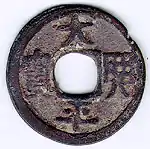Khải Định Thông Bảo
The Khải Định Thông Bảo (Hán tự: 啓定通寶) was a French Indochinese sapèque coin produced from 1921 until 1933, the design of the coin was round with a square hole that was used for stringing them together. Khải Định became King of Annam in 1916 the funding for the production of new cash coins was reduced by the Hanoi Mint which lead to the demand of the Vietnamese market for low value denominations to not be met, furthermore, after Hanoi reduced funding for the Thanh Hóa Mint, which until that time was producing enough low denomination cast cash coins to meet the market's demands, which caused most, but not all, of the production of cash coins at the mint to cease in 1920.[1] In response a new committee was formed in Hanoi which ordered the creation of machine-struck Khải Định Thông Bảo cash coins, these are the first machine-struck four character Thông Bảo (通寶) coins in Vietnam with the reigning emperor's name as the French government had prior tried to introduce a Cochinchinese 2 sapèque coin that continued under French Indochina that weighed 2.05 grams and had a nominal value of 1⁄500 piastre, later the colonial government of the French Protectorate of Tonkin had unsuccessfully tried to introduce a zinc milled sapèque produced by the Paris Mint with a nominal value of 1⁄600 piastre from 1905 until 1906. Unlike the earlier attempts at producing machine-struck cash coins by the colonial French authorities the Khải Định Thông Bảo proved to be much more successful as the first series had a production of 27,629,000 coins while the second series greatly exceeded this with around 200,000,000 coins produced in Huế, Haiphong, and Hanoi.[4][5] The Khải Định Thông Bảo continued to be produced long after the death of Emperor Khải Định under his successor Bảo Đại until it was phased out by the Bảo Đại Thông Bảo (保大通寶) in 1933.[6][7]
| Value | 1 văn (1⁄200 French Indochinese piastre)[1] |
|---|---|
| Mass | first series = 2.28 g second series = 2.10 g |
| Diameter | 22 mm |
| Thickness | 1 mm |
| Composition | Brass |
| Years of minting | 1921–1933 |
| Mintage | 27,629,000 (first series) 200,000,000 (second series) |
| Obverse | |
_-_Art-Hanoi_03.jpg.webp) | |
| Design | 啓定通寶 (Khải Định Thông Bảo) |
| Reverse | |
_-_Art-Hanoi_04.jpg.webp) | |
| Design | Blank[2][3] |
Because the machine-struck Khải Định Thông Bảo cash coins were heavier than the earlier milled 2 sapèques produced by the Paris Mint, they were likely valued at 1⁄200 piastre.[1] A number of the machine-struck cash coins were produced by Poinsard & Veyret Comptoirs D’Extrême-Orient in Hải Phòng, French Tonkin.[1]
The inscription "Khải Định Thông Bảo" was also used for non-cash coins produced under the reign of Emperor Khải Định for tiền (錢) and lạng (兩) coins made from silver and gold, respectively.[8] Although more commonly the inscription Khải Định Niên Tạo (啓定年造) was used for silver ingots (sycees).[9]
References
- Howard A. Daniel, III 2018, p. 79.
- French Southeast Asia Coins & Currency by Howard A. Daniel III (page 97).
- 啟定 Khải Định 1916-1925 cash coins. By Sema (Art-Hanoi) Cash coins of Bao Dai were the last cash-style coins produced in the world. Retrieved: 05 March 2018
- Đỗ Văn Ninh (1992), Tiền cổ Việt Nam, Nhà xuất bản Khoa học xã hội (in Vietnamese)
- Lục Đức Thuận, Võ Quốc Ky (2009), Tiền cổ Việt Nam, Nhà xuất bản Giáo dục (in Vietnamese)
- "Sapeque and Sapeque-Like Coins in Cochinchina and Indochina (交趾支那和印度支那穿孔錢幣)". Howard A. Daniel III (The Journal of East Asian Numismatics – Second issue). 20 April 2016. Retrieved 4 March 2018.
- Dr. R. Allan Barker. (2004) The historical Cash Coins of Viet Nam. ISBN 981-05-2300-9
- Linh, Vietnamese in Vancouver Khải Định Thông Bảo Archived 2018-03-26 at the Wayback Machine. (in Vietnamese) Xin visa du lịch – Đặt phòng & vé máy bay – Hỗ trợ 24/7 Retrieved: 10 February 2018.
- François Thierry de Crussol (14 September 2015). "Monnayage de Khải Định 啓定 (1916-1925) - Khải Định currency (1916-1925)" (in French). TransAsiart. Retrieved 24 April 2020.
Sources
- Howard A. Daniel, III (3rd edition, 2018) The Catalog and Guidebook of Southeast Asian Coins and Currency. Volume I: France. ISBN 0-931960-01-0


_-_Art-Hanoi_01.jpg.webp)
_Art-Hanoi_02.jpg.webp)
_02.jpg.webp)